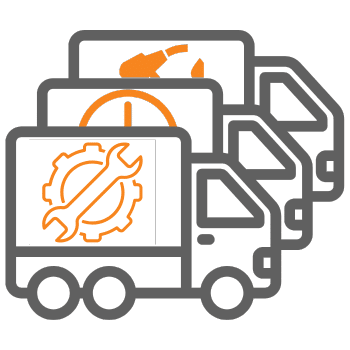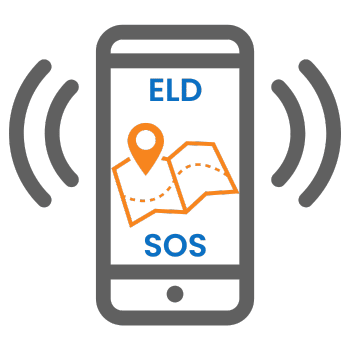Got Questions? We Have Answers
GPS Tracking, Telematics & Dashcam FAQs
Unlock Efficiency, Control Costs, and Drive Success.
Answers to Common GPS Tracking & Telematics Questions
Fleet management FAQs
What is the difference between live and passive GPS tracking systems?
The data collected is generally the same for both types of systems. Live vehicle tracking transmits the GPS data collected to cellular networks which route it to a website where you view the data. It’s considered live tracking because it is visible shortly after being logged.
Passive GPS trackers store the GPS information on the tracker until the truck returns to a central location or office. When the truck is within range of a wireless base station, usually under 500 yards, the GPS tracker will transfer the GPS tracking data. The GPS data is then put in a database that is connected to fleet management software where you can view it online. Passive technology is no longer readily available.
Is live vehicle tracking really "live"?
Almost, in some cases. There is a cost for every GPS coordinate transmitted for live tracking systems. The higher the track resolution, the more expensive the monthly subscription service. There are systems that will actually log a GPS point every 10 seconds but have very high monthly service fees. Other systems like the GO system in ProPlus mode displays fluid motion on the map with just a few seconds delay.
Most fleet management systems report a position about every 60 seconds. Some systems log GPS data based on driving behavior, not a set time interval. This tends to provide a higher resolution of the actual vehicle path traveled but at the standard market rate. This service is very affordable when this level of resolution is needed.
Contact your sales consultant to learn about volume pricing.
What are the pros and cons of live truck tracking systems?
Since the GPS data collected is generally the same, the speed at which you can access the vehicle’s location provides one benefit. You can make better dispatching and scheduling decisions when you have good live data. Live tracking systems don’t require any installation of a local antenna on your building, computers to store the data, or tracking software on a server. Live truck trackers generally are viewed through a convenient website.
Another benefit to live vehicle tracking is that vehicles don’t have to return to a central location to get the data. Many fleet managers need live data to make decisions but the trucks don’t return to a central location often enough to make transportation and logistics decisions. GPS data that is over 2 weeks old is really not of significant value to most fleet managers.
The price of live tracking systems is subsidized by the monthly fee that goes with them. This keeps the capital investment lower.
The primary disadvantage to live GPS trackers is that there must be a monthly service fee. The monthly fee is used to cover the cost of moving the GPS track and telematics data across the cellular network, subsidizing the equipment investment, development, customer service, and profit for the service provider. Because there is a monthly subscription service, vendors are motivated to support your account and address needs.
A second disadvantage is that there is not cellular coverage in all areas. At times you will be paying a monthly subscription fee and not be able to track your vehicles in real-time. This is just part of how the technology works, very much like a cell phone.
Which cellular network is best?
Think about where your vehicles operate, not where your office is located. The goal is to move as much data in real-time as possible. Most GPS trackers will store data when outside cellular network coverage and upload later to prevent data loss.
The more real-time vehicle location information you have the better the dispatching decisions you can make. You also need to understand voice network coverage is different than data. By testing a device before you invest you can better understand the coverage in your area of operation.
What is involved in the GPS installation process?
Installation is a very important component of a successful deployment, especially for large fleets. This is a step that is often glossed over during the sales process. A good partner will discuss the GPS install plan in detail and demonstrate 1. experience 2. an organized plan. Simply saying it is not an issue is not good enough. As with everything, there are limitations and requirements that impact you. Additionally, you need to know how service work is done and what happens when you move a device to a new vehicle. More About GPS Installation
How GPS Tracking Systems Work
GPS satellites transmit radio signals to a receiver in the GPS tracker. When signals are received from 3+ satellites, location, speed and altitude can be determined. GPS location data is transmitted from the GPS tracker to a cell phone tower. The data is routed to an IP address based on the IMEI of the GPS tracking device. The data is stored in a databased and made available through a web portal in most scenarios.
Tracking Devices for Cell Phone
All consumer cell phones include a GPS tracking receiver. Location is used for everything from map navigation, to tracking the stores you enter so advertisers can target you with ads.
GPS tracking can typically be disable through the Settings functions. Location will likely turn back on for the phone maker or operating system when you restart your phone or click on an obscure button.
Bluetooth Tracker
A bluetooth tracker is a small tracking device that utilizes another device to transmit data to a cell tower for routing to a web portal. By using a Bluetooth connection, the bluetooth tracker is able to reply on the other device to supply the power and technology to get the data where is needs to go. Most often, a bluetooth tracker connects to a cell phone. This connection enables the bluetooth tracker to use the internal battery very efficiently providing a long operational life.
GPS Tracking
Your content goes here. Edit or remove this text inline or in the module Content settings. You can also style every aspect of this content in the module Design settings and even apply custom CSS to this text in the module Advanced settings.
GPS Tracking FAQs – Intangibles
Why do prices vary?
The old adage of “you get what you pay for” holds true in the GPS tracking industry. With lower prices come fewer services, features, and options. Low price leaders typically don’t have as many staff members or resources to support you after the sale. They may have a great salesperson or a cool application but ROI is achieved after the honeymoon period is over. Knowing your partner is charging you enough to provide the resources you need shows you that they have a good business model. A win-win relationship is required to be successful; just like you have with your customers. Pay more, get more, and expect more ROI.
How long should it take to recover my investment?
This varies for a variety of reasons. The ROI for a typical service company is under 90 days. This includes the initial capital investment as well as the first year’s subscription service. ROI will also vary by fleet management practices. Fleets that are better run before installing GPS will take a little longer. Fleets with more room to improve can receive very rapid ROI, often under 30 days! best in class fleets can expect about $2,500 in savings per vehicle. Calculate your ROI
What areas can I expect to see improvement?
This will vary by fleet practices and leadership. If the company leaders are not willing to use the data to make decisions or hold drivers accountable, there is no point in making the investment. ROI requires a commitment to change with policies to support the program and the strength of leadership to enforce the policies.
Typical areas of improvement include:
- Reduce fuel expenses resulting from a host of reasons
- Reduced accidents
- Improved productivity
- Reduced regular and overtime wages for the same amount of work.
- Improvements in fleet maintenance expenses with fewer miles and lower maintenance costs.
Dispatching service can reduce or totally eliminate expensive cell phone plans. This often provides a huge ROI in a very short period. Going from $50-$80 a month in cell phone costs to a $10 dispatching service fee is a major difference for most fleets.
You can actually hire better drivers and retain the “best of the best” long-term. Introducing GPS tracking during the interview process will scare off many that don’t intend on working a full day once away from the office.
With reduced speeds, fewer miles, and more attention is given to driving, GPS tracking can have a major impact on workers’ comp claims and other insurance expenses.
What should I look for in a fleet management partner?
This is really determined by your needs. If you don’t know your top 3 issues and the GPS provider doesn’t try to learn them from you, keep looking. How can a solution to a problem be provided if the problem is not defined? The more work you do to define and articulate your needs, the more likely you are of achieving or exceeding them. If you cannot do this step, ask yourself if you are ready to collect data to make business decisions.
Experience counts. Industry experience is at the top of the list. If your account manager is new, do you want to entrust your job to them when you make a recommendation to your boss? If the consultant is new, do they have a company behind them with experience and training?
Does the GPS solution recommended resolve my top 3 “must-have” issues? If the solution does not resolve the “must-have” issues, you have to keep looking. You want a solution for your “must-have” issues and as many of your “like to have” issues as possible. If you are willing to forgo your “must-have” issues you have not properly defined your criteria. What happens after the sale is where you make your money back. Get comfortable with the people and resources available to help you drive your ROI. It will take up to two years to fully understand and implement all the potential savings available.
In recent years there have been more online-only vendors entering the market. Online only means no people to talk to when you have an issue. Their solution to your problems is limited to an FAQ page, chat or email. Having human interaction readily available increases the efficiency of resolving issues that always come up with technology. Confirm they have technical support on staff and there is more than one person you can access. Having a larger trained staff means you are not depending on one person being available when you need help fast.
Will drivers quit when we implement GPS tracking?
Don’t be. If you have a driver quit, you just saved a ton of money. It seldom happens but anyone that is afraid to be tracked is hiding something. If they quit they can drag your competitor down who isn’t using GPS tracking and you don’t have to pay unemployment. All drivers are nervous at first, but good leadership overcomes this fear and builds a stronger company.
How to introduce GPS tracking to employees. Learn how
What training is needed and available?
You cannot receive your ROI if you don’t know how to use the system. Some companies have sales people act as trainers, some offer manuals, some offer videos and some offer online training. A combination of all is important because your needs change according to employee and time available. Many busy fleet managers might be able to watch a video before drivers come in while office staff might be able to attend a webinar. Fleetistics offers all and we have a dedicated corporate trainer to manage content and lead live online sessions. Onsite training is also an option. View Training Videos
Service after the sale (STIR)
STIR is an acronym for Service, Training, Implementation, ROI. This represents a core value of Fleetistics and is designed to keep everyone focused on our customers and partners.






